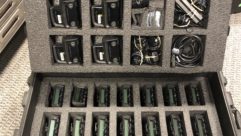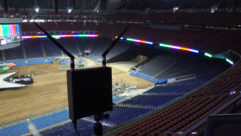
AV Adds Flexibility To Rodeo Event
Outdoor rodeo and entertainment show bolsters its sound and video systems to engage an audience of more than 1.2 million.
Custom trailers transport 12.5-foot-tall by 16.7-foot-wide LED screens to and from each event at the Calgary Stampede rodeo and entertainment show in Calgary, Canada. Each mobile LED screen consists of 25 Lighthouse Technologies LH 1650D LED panels.
CHALLENGE: Reinforce the existing audio system, and install bright, easy-to-see video displays that can quickly move from one- venue to another in a limited amount of time.
SOLUTION: Add new loudspeakers, and bring in more than 100 LED panels, and use custom trailers to transport the screens to different locations in less than 20 minutes.
ALTHOUGH IT’S BILLED as the “Greatest Outdoor Show on Earth,” the 10-day-long Calgary Stampede rodeo event in Calgary, Canada, has a tough time exceeding spectator expectations year to year. Increasing prize money to more than $2 million in 2005 brought in talented contestants, but the event’s organizers wanted to add a more dynamic component to the show.
The Queen Mary stage at the Calgary Stampede features a 32-panel, 10-foot-tall by 23.3-foot-wide LED screen consisting of Lighthouse Technologies LH 1650D LED panels. The stage hosts nightly variety shows during the 10-day event.
To help attract a larger audience and engage the more than 1.2 million people that come to the event annually, Stampede Production Designer Pierre Marleau turned to Peter Penkala, president of Ontario, Canada-based video and control system provider and integrator MultiVision Inc. (MVI) to bolster the show’s existing video system.
After adding a few LED video displays to the top of the main grandstand stage starting in 2000, Marleau contracted MVI to increase the total to 104 panels, grouped into six separate screens. Penkala was hired to supply, install, and format the LED panels, as well as manage scaling, distribution, and overall control of the system.
Dynamic video
Working quickly is a must at the Calgary Stampede because the show’s two largest video screens are used for both the rodeo events and the separate Grandstand Show, with less than 20 minutes in between the events. To speed up the task, Calgary Stampede and MVI, worked with Calgary-based engineering firm BRT Consulting and Calgary-based Bow Ridge Trailer Manufacturing to create custom trailers to move the equipment (see sidebar on page 26).
The trailers were designed to move the 12.5-foot-high by 16.7-foot-wide stage left and right screens, which are comprised of 25 2.5-foot-tall by 3.3-foot-wide Lighthouse Technologies LH 1650D LED panels.
“We gave them the specifications of the screens and their pick-up points, along with all of the weights and dimensions to make sure everything would be in balance,” Penkala says. “They have hydraulic systems that raise the screens 15 feet from their travel height.”
CREATING THE CUSTOM TRAILERS
To maximize the use of its $150,000 video system, the organizers of the Calgary Stampede rodeo event in Calgary, Canada, wanted to use some of the same video equipment for multiple events. While more than half of the 104 Lighthouse Technologies LH 1650D LED panels Ontario, Canada-based video and control system provider and integrator MultiVision Inc. (MVI) provided are mounted to a stage, two 25-panel LED video displays serve as standalone, supplementary displays.
Calgary Stampede Production Designer Pierre Marleau wanted to use these displays for the rodeo events as well as the Grandstand Show, but moving them in the less than 20-minute break between each event made that impossible.
To solve the problem, Marleau turned to Calgary-based engineering firm BRT Consulting Ltd. and Calgary-based Bow Ridge Trailer Manufacturing Ltd. to create custom trailers that could be used to move the 12.5-foot-high by 16.7-foot-wide stage left and right screens from the rodeo location to the Grandstand stage in about 10 minutes.
The wagon-style trailers are 8.5 feet wide and 19 feet long, and include two 7,000-pound axles — a rear fixed axle and a front steering axle. Each trailer has a 3,500-pound load capacity, and includes two hydraulic lift arms. The trailers include a weatherproof power transfer box that serves as a power interconnect to a power pack.
The hydraulic arms enable the screens to move from a 13.5-foot traveling height to an operating height of 24 feet. The trailers also include a towing hitch, which enables a tractor or truck to pull them from event to event.
So far, the show’s new trailers have worked flawlessly, and the Calgary Stampede has decided to order more to make the moving process even quicker. “We’ve actually just approved the construction of two more of these trailers for a total of four,” Marleau says.
Once the rodeo is over for the day, MVI’s crew unhooks the Belden 1694 SDI video signal cable that runs more than 300 feet from the control bunker to the rodeo site. MVI also uses 12-gauge cable to send power to the moveable screens. The crew then drives the trailers to the main stage —nicknamed the “Queen Mary” — for the nightly Grandstand Show. The two mobile screens are positioned 200 feet away from the stage. Once the mobile screens are in place, they’re reconnected to a second set of SDI cables.
In addition to the two mobile screens, the stage includes two 12.5-foot-high by 6.6-foot-wide LED screens — each consisting of 10 LED panels — mounted on towers located on each side of the stage. Additionally, a 2.5-foot-high by 20-foot-wide banner screen comprised of six LED panels is mounted on the top center of the stage. In the middle of the stage, a 32-panel, 10-foot-high by 23.3-foot-wide screen on an elevator rises into place when the nightly show starts.
Although Marleau and his staff produce most of the video content displayed on the screens, Penkala and his staff control and route the images to the right screens at the correct time. The LEDs must also be synchronized with the other systems.
“We’re working from SMPTE timecode that brings in audio and lighting elements so all of the cuing is synchronized,” Penkala says.
He uses a Folsom Screen Pro router package with preview monitors to route and scale the video feeds that Marleau’s staff records. The router package receives video signals from three Doremi Labs motion MPEG video servers. Marleau’s staff generates content in component video format, which is scaled via a Snell & Wilcox SLH video scaler to SDI signal and converted to the correct aspect ratio.
Of the roughly $400,000 the Calgary Stampede budgeted for AV, about $150,000 was allotted for video system, including the labor, support, transportation, and rental of the 104 Lighthouse LH 1650D LED panels. Although the initial cost of the screens was expensive, Marleau says they’re an invaluable piece of the event.
“When we were first thinking about bringing the screens onboard, we got a lot of resistance from management because they’re expensive,” he says. “They were saying that it was a lot of money, which could be better spent on fireworks. But after the reaction we got, management said, ‘cut the fireworks, cut whatever, but you can’t remove the video screens from the show.’”
Audio is taken to new heights
In addition to enhancing the show’s video system, Dan Frerichs, general manager of Sound Art International, a Winnipeg, Canada-based live performance audio solutions provider and integrator, worked with Marleau to add audio upgrades to the event. Frerichs, who manages the audio system and has been working with the Stampede for 10 years, used Electro-Voice Xvls long-throw and Xvlt medium-throw line array cabinets, as well as Electro-Voice Xsub/f subwoofer flying cabinets mounted on four scissor lifts for the rodeo and Grandstand shows. The loudspeakers are powered by 16 Electro-Voice P3000RL 3,600 W power amplifiers with built-in delay, equalization, and crossovers.
Frerichs says he would have preferred to mount the loudspeakers to semi-permanent structures to better control their coverage, but with several events in a small area, interference was a problem.
“We can’t set up big scaffold towers, because that would cause sightline issues for the other events on and around the stage,” he says. “The last few years we’ve upgraded to these larger line arrays that we drive out on scissor lifts and put to correct heights.”
To determine the correct placement of the scissor lifts and make aiming calculations for the clusters used in each event, Frerichs took physical measurements of the venues and input them into a proprietary Electro-Voice spreadsheet. The coverage patterns were then determined and confirmed based on CAD drawings of the space.
To better prepare for this year’s show, Frerichs also decided to add a Yamaha M7CL 48×16 digital mixing console to help save time and money.
FOR MORE INFORMATION
- AKGwww.akg-acoustics.com
- Beldenwww.belden.com
- Doremi Labswww.doremilabs.com
- Electro-Voicewww.electro-voice.com
- Folsomwww.folsom.com
- Lighthousewww.lighthouse-tech.com
- Sennheiserwww.sennheiserusa.com
- Shurewww.shure.com
- Snell & Wilcoxwww.snellwilcox.com
- Yamahawww.yamaha.com
“There’s a bit of limited space at the mix positions, so we can’t use many for outboard racks,” he says. “With this product, everything we need is onboard — compressors, effects, and more. The show is the same every day, so we’re able to program the soundboard que-to-que. And then we just step through the show changes.”
The numerous wireless and wired microphones used in the show, including Shure SM57/58/58S and BETA91, AKG C535EB, Electro-Voice N/D468B, and Sennheiser 421 mics, are mixed via the Yamaha mixer and arrive at the console through an analog snake system installed in the stage. The analog snake reduces the amount of cable needed to run the 600 feet from the stage to the console.
Still, Frerichs hopes to further reduce the length of the cable run in the near future. For the 2007 show, the Stampede plans to upgrade to a Whirlwind ESnake digital audio snake, which will run the audio signal through a single fiber to save space and simplify the long cable runs.
Paul Kramer is associate editor of Pro AV. He can be reached at [email protected].










